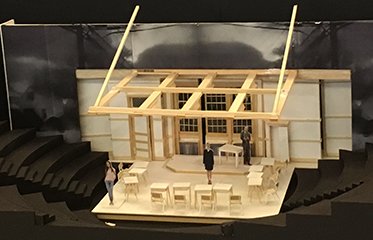Richard Hoover, the set designer for The Babylon Line, has rich credits in movies, TV, and theater, so I asked him to explain briefly the differences between working in each medium. Speaking on the phone from Montreal, where he has been working on Brad’s Status, a new movie starring Ben Stiller, Hoover replied: “Movies often involve locations so as the production designer you have to think in terms of the physicality of where you’re working. You don’t control the look the way you do in the theater.”
As for television, where Hoover has worked on such series as “The Newsroom, “Enlightened,” and “Twin Peaks,” he explained, “A single TV show is like a movie feature. On a series, you create a machine that keeps working. You’re always prepping, shooting, and wrapping.” Hoover said that in the United States “we don’t have the tradition of the designer being on the set, whereas in Europe they do. The production designer is not involved with camera angles or the set-ups, but there you are probably more directly involved with the look of the piece.”
In the theater, the design is generally worked out quite far in advance. “That was the case with The Babylon Line, Hoover said. “Our main challenge is to adjust the set from the proscenium” – which is how it was done two summers ago at New York Stage and Film, at Vassar’s Powerhouse Theater, in Poughkeepsie, New York – “to the thrust of the Newhouse.” For the new configuration, the desks and chairs of the classroom-like set will be separated. “That allows for more flexibility – for a more open stage.”
Hoover grew up in the Midwest and got his start with professional theater in Chicago. “I wasn’t at Steppenwolf there,” he said, “though I have great affection for that theater,” which was co-founded by Terry Kinney, the director of The Babylon Line. Hoover has worked with Kinney on a couple of plays, as well as on a short film.
Hoover’s movie credits also include Girl, Interrupted, in 1999, which won Angelina Jolie her first Academy Award. That same year, Hoover won a Tony for his set design of the Tennessee Williams play Not About Nightingales. The show takes place in a prison, and the New York Times described the production’s look as “intense” and “vivid.” Hoover speaks fondly of the play, and of its actors. He himself had wanted to be an actor, but said that early on he had “no guidance” in that career, he so moved over into design.
Hoover still does his own sketches. “In pencil,” he explained. “But I need an illustrator to complete them. In a good week, I can do three good pencil sketches.” Hoover says that an art-school background is very helpful for a production or set designer. “I wish I had more fine-arts training. I was able to make my career without much of that background. I was lucky to be helped along occasionally by talented people.”
Hoover dreams of designing plays non-traditionally. “I would love to do my job by being in rehearsal and watching the actors.” Whatever the process, Hoover said that a designer must always keep the narrative in mind. “It’s essential for a designer to learn to ‘speak story.’”
Brendan Lemon is the editor of lemonwade.com.
